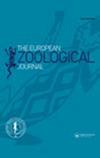Morphology of the stridulatory organs of Iberian myrmicine ants (Hymenoptera: Formicidae)
引用次数: 5
Abstract
Abstract The importance of chemical communication in ants has been widely reported, but acoustic communication also has a significant role in those subfamilies that show this behaviour. In this study, we expand the knowledge about stridulatory organs of the subfamily Myrmicinae (Hymenoptera: Formicidae) with the first description of the stridulatory organs of five species (Aphaenogaster striativentris, Goniomma blanci, G. hispanicum, Oxyopomyrmex salulcyi and Pheidole pallidula). Subsequently, we made a morphometric study of 16 species to make comparisons of their stridulatory organs. Scanning electron microscope (SEM) photographs were taken for the morphological study, and the head and dimensions of the pars stridens, together with measurements of the striae, were used for the morphometric analysis. The five myrmicines studied show typical stridulatory organs for Formicidae. We also add two genera (Goniomma and Oxyopomyrmex) to the list of genera that are known to have stridulatory organs. The morphometric study shows a positive correlation between the body size and the size of the pars stridens and between the length and width of the pars stridens. However, a relation between the size of the stridulatory organs and the size of the striae of the pars stridens was not detected. Stridulatory organs have been shown to have significant interspecific differences in size.伊比利亚金蚁的鸣声器官形态学(膜翅目:蚁科)
化学通讯在蚂蚁中的重要性已被广泛报道,但声学通讯在那些表现出这种行为的亚科中也起着重要作用。在本研究中,我们通过首次描述五种(Aphaenogaster striativentris, Goniomma blanci, G. hispanicum, Oxyopomyrmex salulcyi和Pheidole pallidula)的鸣声器官,扩展了对桃蚜亚科(膜翅目:蚁科)鸣声器官的认识。随后,我们对16个物种进行了形态计量学研究,比较了它们的鸣声器官。形态学研究采用扫描电子显微镜(SEM)照片,形态学分析采用树突的头部和尺寸以及条纹的测量。所研究的五种桃螨具有典型的虫科鸣声器官。我们还增加了两个属(Goniomma和Oxyopomyrmex)到已知有鸣声器官的属列表。形态计量学研究表明,体型与足部大小、足部长度与足部宽度呈正相关。然而,没有发现鸣器官的大小与鸣部的条纹大小之间的关系。鸣声器官在大小上有显著的种间差异。
本文章由计算机程序翻译,如有差异,请以英文原文为准。
求助全文
约1分钟内获得全文
求助全文

 求助内容:
求助内容: 应助结果提醒方式:
应助结果提醒方式:


